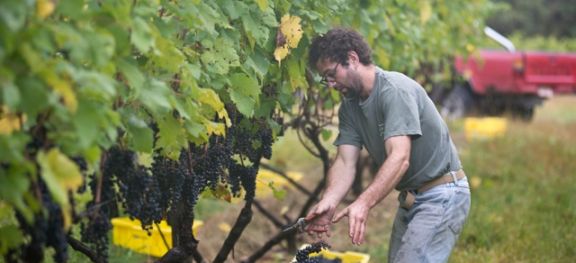Virginia 2014: wonderfully average


Jim Law of Linden Vineyards provides us this report on the grape harvest in the US state of Virginia.
Virginia vineyards are now in our second generation of evolution. The steepest ascent of our learning curve fell on the backs of the pioneers of the 1980s, allowing today’s winegrowers to focus on fine-tuning rather than survival. The saying 'Climate is what you plan for and weather is what you get' is an appropriate reflection on both the long- and the short-term lessons learned.
Vineyards are now planted with varieties better suited to our climate. We have learned that Cabernet Franc, Cabernet Sauvignon and Chardonnay, if planted on the right soils and slopes, do well in our typical growing season. Gone are Pinot Noir, Zinfandel and Gewürztraminer, which can only grow good wine in one or two years a decade. This is why the somewhat unremarkable 2014 growing season was so good: we got what we planned for.
Every growing season has its personality, and as average as 2014 was, there were three aspects that shaped the character of the wines.
A very long cold winter damaged some vines and delayed spring. A late start to spring can end up as a very late harvest. The fear was that late-ripening varieties such as Cabernet Sauvignon and Petit Verdot would run out of warmth come October. We were prepared to reduce our potential yields by removing a significant amount of the clusters in July. A smaller crop would ripen faster.
However, July was beautiful. Dry, warm weather slowed the vine’s vegetative growth. Instead of putting energy into producing more leaves, which will happen in a wet summer, the vines put their energy into ripening the grapes. We knew something good was to happen when veraison occurred sooner (and faster) than expected.
Spring and mid summer lay the foundation of the vintage, but late August through mid October determine the style, character and quality of the wines. Harvest began in early September. It was typical of the ‘cat and mouse’ picking strategies that we are all now accustomed to. A few days of sunny delightful weather followed by showers characterised the start of harvest.
Mid September to early October was our big break with very little rain and mild temperatures, although it remained somewhat cloudy. Ripening took its time with lower than average sugars and higher than average acids. Under these conditions, Chardonnay was the white grape that benefited most, making a linear, precise wine with possibly a very long ageing potential.
On the red side, Merlot was a bit stubborn. It refused to gain the flesh and fat that it is known for. We are hoping for some weight gain once malos have finished. Cabernet Franc produced wines with a rich mid palate and forward fruit, but lacking in length. Cabernet Sauvignon, which had very ripe skin tannins, will supply the length. However, its seeds were not fully developed, and the forecast was for significant rains beginning 10 October. Those who picked before the rains and extracted wisely (avoiding pulling out bitter components from the seeds) were rewarded with plush, energetic Cabernet Sauvignon.
What do we expect from the 2014 wines? One can’t help from using the word ‘classic’. For those wanting to get an idea of what a Virginia wine tastes like, 2014 will be one of the best expressions of who we are.
2014 will be 'Old World' in style because of the cooler temperatures and cloudier days. They will be lower in alcohol with some bright acidity. This is a compelling style for the dinner table, but perhaps not for wine-writer points.
Become a member to view this article and thousands more!
- 15,436 featured articles
- 274,222 wine reviews
- Maps from The World Atlas of Wine, 8th edition (RRP £50)
- The Oxford Companion to Wine, 5th edition (RRP £50)
- Members’ forum
- 15,436 featured articles
- 274,222 wine reviews
- Maps from The World Atlas of Wine, 8th edition (RRP £50)
- The Oxford Companion to Wine, 5th edition (RRP £50)
- Members’ forum
- Commercial use of our Tasting Notes